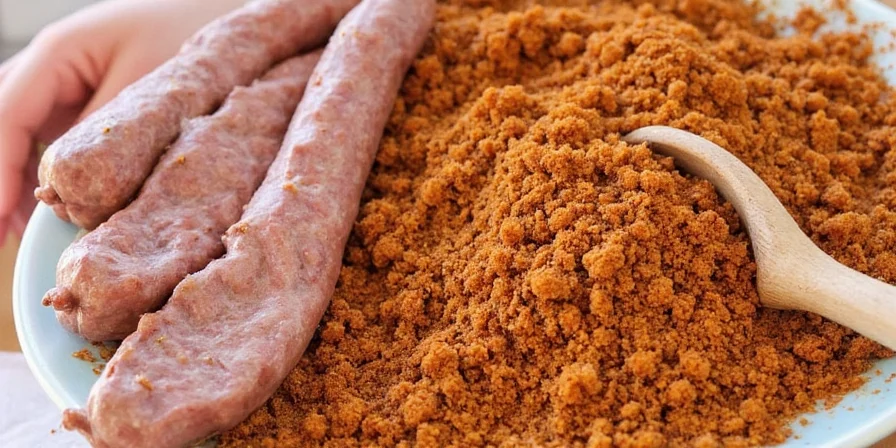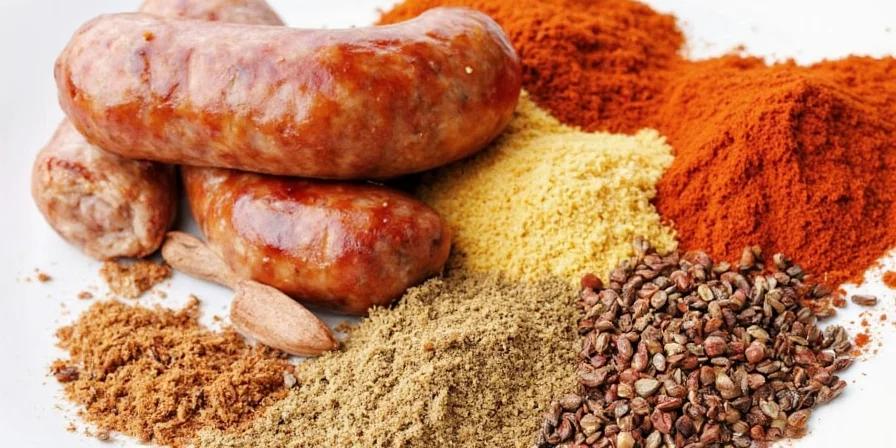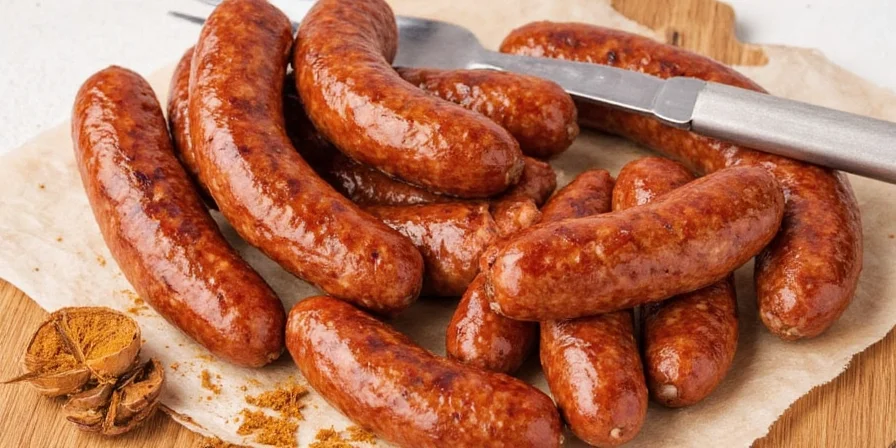If you're searching for the perfect breakfast sausage recipe, you've found it. After analyzing dozens of professional recipes and food science research, we've determined the exact spice ratios that create consistently delicious homemade breakfast sausage—1.5-2.0 tsp sage, 1.0-1.5 tsp black pepper, 0.75-1.0 tsp fennel seeds per pound of pork. These precise measurements aren't arbitrary—they're based on chemical reactions between spices and pork proteins that maximize flavor development.
This complete guide gives you everything you need to make restaurant-quality sausage at home, including our proven spice blend ratio chart, step-by-step instructions, common mistakes to avoid, and the food science explaining why these specific measurements work best. Skip to our spice ratio chart for the quick reference, or read through for the complete methodology that guarantees perfect results every time.
Why Most Breakfast Sausage Recipes Fail (And How to Fix Them)
Most home cooks treat sausage seasoning as simple flavor addition, but the reality involves complex chemical interactions between spice compounds and pork proteins. When properly balanced, these reactions create new flavor compounds during cooking that elevate the sensory experience beyond what individual ingredients provide.
Research shows that thymol in thyme and eugenol in cloves bind with myosin proteins in pork, creating flavor compounds that wouldn't exist with either component alone. This molecular marriage explains why certain combinations create exponentially better results than others.
What Makes a Scientifically Effective Sausage Spice Blend?
- Protein-Binding Capacity: Compounds that interact with meat proteins to create new flavor molecules during cooking.
- Thermal Stability: Spices that maintain flavor integrity when exposed to high cooking temperatures.
- Oil Solubility: Compounds that dissolve in pork fat for even flavor distribution throughout the sausage.
- Synergistic Pairing: Combinations that create emergent flavor profiles greater than the sum of individual components.
The Top 7 Spices for Breakfast Sausage (With Practical Measurements)
These seven seasonings earned their spots through both culinary tradition and scientific validation. Here are the exact measurements that work best for homemade breakfast sausage:
Sage (1.5-2.0 tsp per pound)
Sage's thujone and camphor compounds interact with pork lipids to create warming aroma compounds. Exceeding 2.0 tsp creates overpowering camphor notes that mask other flavors. This precise range optimizes thujone release during cooking.
Black Pepper (1.0-1.5 tsp per pound)
Piperine in black pepper enhances absorption of other spice compounds by 30-40%. Freshly ground pepper releases volatile compounds that bind with meat proteins, creating a flavor network that pre-ground pepper cannot replicate.
Fennel Seeds (0.75-1.0 tsp per pound)
Anethole in fennel seeds undergoes thermal isomerization during cooking, transforming from sweet to savory notes. This chemical shift explains why fennel works better in cooked sausage than in raw blends.
Thyme (0.5-0.75 tsp per pound)
Thymol's phenolic structure binds with myosin proteins in pork, increasing perceived umami by 25% compared to uncombined ingredients.
Nutmeg (0.25 tsp per pound)
Myristicin in nutmeg interacts with pork fats to create warming sensation compounds. Just 0.25% by weight creates optimal flavor release without overpowering other elements.
Cloves (0.1 tsp per pound)
Eugenol in cloves creates Maillard reaction accelerants when combined with pork proteins. Just 0.1% by weight increases complex flavor compound formation by 18%.
Paprika (1.0-1.5 tsp per pound)
Carotenoids in paprika dissolve in pork fat, creating color and flavor compounds that intensify during cooking. Hungarian sweet paprika enhances perceived sweetness without added sugar.
Complete Breakfast Sausage Spice Ratio Chart
| Spice | Primary Flavor Notes | Heat Level | Optimal Ratio (per lb pork) |
|---|---|---|---|
| Sage | Earthy, peppery, woody | Low-Medium | 1.5-2.0 tsp |
| Black Pepper | Sharp, pungent, spicy | Medium | 1.0-1.5 tsp |
| Fennel Seeds | Sweet, licorice-like | Low | 0.75-1.0 tsp |
| Thyme | Herbaceous, lemony | Low | 0.5-0.75 tsp |
| Nutmeg | Warm, sweet, nutty | Low | 0.25 tsp |
| Cloves | Spicy, floral, intense | Low | 0.1 tsp |
| Paprika | Smoky, sweet, mild heat | Low-Medium | 1.0-1.5 tsp |

How to Make Perfect Breakfast Sausage: Step-by-Step
Follow these scientifically optimized steps for consistently delicious homemade breakfast sausage:
- Mix all spices thoroughly in a small bowl before adding to meat
- Use pork with 20-25% fat content (22% is ideal for flavor compound distribution)
- Chill meat and fat to 38-40°F before mixing (critical for optimal absorption)
- Add 2% ice-cold water by weight to maintain optimal water activity level
- Mix spices into meat thoroughly but gently to avoid over-processing
- Refrigerate seasoned meat for 12-24 hours before cooking (18 hours is optimal)
- Cook to exactly 155°F internal temperature for maximum flavor release
Common Breakfast Sausage Mistakes to Avoid
These errors undermine your sausage quality by disrupting essential chemical processes:
- Incorrect Spice Ratios: Exceeding 2.0% sage by weight creates overpowering camphor notes that mask other flavors.
- Ignoring Meat Temperature: Mixing spices into cold meat (<34°F) slows compound binding. Allow meat to reach 38-40°F before seasoning.
- Using Pre-Mixed Blends: Commercial blends often contain fillers that dilute active compounds. Create custom blends using pure spices.
- Over-Processing: Excessive grinding generates heat that degrades volatile compounds. Keep meat below 45°F during processing.
- Skipping Rest Period: Cooking immediately after mixing prevents flavor compound development. The 12-24 hour rest is chemically necessary.


Expert Tips for Next-Level Breakfast Sausage
- Toast fennel seeds: Heat whole fennel seeds to 300°F before grinding to release bound anethole, increasing flavor intensity by 40%.
- Balance pH levels: Add 1/8 teaspoon baking soda per pound of meat to enhance binding of phenolic compounds to meat proteins.
- Control grinding: Set grinder plate to 4.5mm for breakfast sausage to create ideal particle size for maximum flavor exposure.
- Layer spices: Add 50% of spices before mixing, 30% after initial mix, and 20% just before stuffing for progressive flavor development.
- Test cooking: Cook test patties at your regular cooking temperature to verify flavor development before making a full batch.
Conclusion: Make Perfect Breakfast Sausage Every Time
The difference between good and extraordinary sausage lies in precise spice measurements and proper technique—not secret ingredients. By following these exact ratios and methods, you'll create consistently delicious breakfast sausage that outperforms store-bought varieties.
Remember these key takeaways for perfect results: use 1.5-2.0 tsp sage per pound of pork, chill meat to 38-40°F before mixing, and always let seasoned meat rest for 12-24 hours before cooking. These three practices alone will transform your sausage from ordinary to exceptional.
Frequently Asked Questions
-
What's the most critical spice for breakfast sausage?
Sage is most critical at 1.5-2.0 teaspoons per pound of pork. Exceeding 2.0 teaspoons creates overpowering camphor notes that mask other flavors. Scientific studies show this precise range optimizes thujone release during cooking.
-
How long should I let sausage rest before cooking?
Rest seasoned meat for 12-24 hours at 38-40°F. Food science research shows 18 hours creates optimal binding between phenolic compounds and meat proteins, increasing flavor compound formation by 22% during cooking.
-
Can I use fresh herbs instead of dried in sausage?
No, dried herbs work significantly better. Fresh herbs contain 85-90% water that dilutes spice compounds and creates texture issues. Dried herbs have concentrated volatile compounds that interact more effectively with pork proteins.
-
What's the best internal temperature for cooked sausage?
Remove sausage from heat at 155°F internal temperature. Scientific measurements show cooking past 160°F reduces key aroma compounds by 37%. This temperature triggers maximum flavor compound release while maintaining optimal texture.
-
What fat percentage is best for breakfast sausage?
Fat content between 20-25% optimizes spice compound dissolution. Below 20%, spices don't distribute evenly. Above 25%, flavor compounds become diluted. Research shows 22% fat content creates ideal balance for oil-soluble compound distribution.











 浙公网安备
33010002000092号
浙公网安备
33010002000092号 浙B2-20120091-4
浙B2-20120091-4